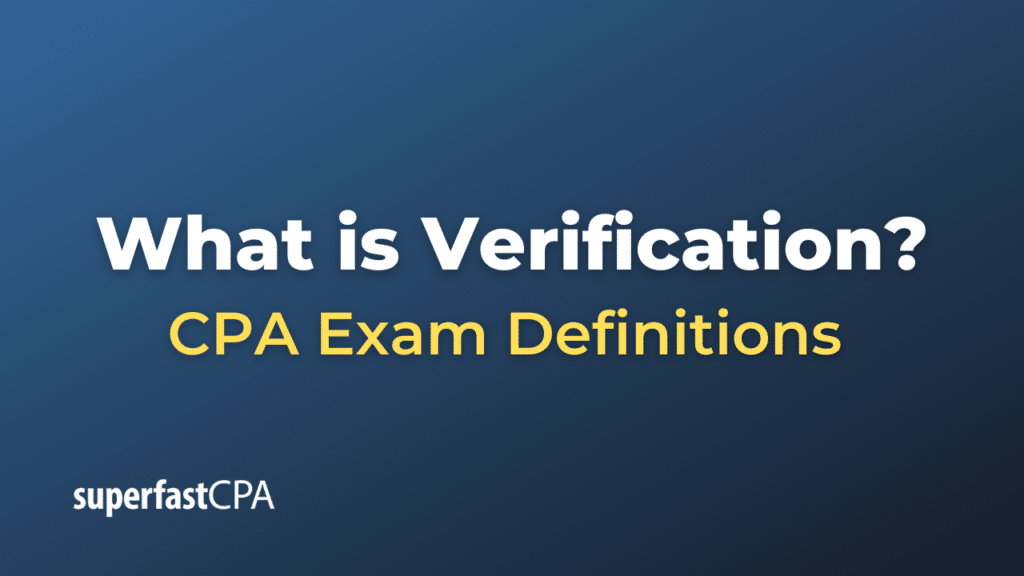Verification
Verification is the process of confirming the truth, accuracy, or validity of a statement, claim, or data. This is a broad concept that is applied in various domains, from science and engineering to law, accounting, and even everyday life. The primary purpose of verification is to establish the reliability of information, data, or systems, often through a structured set of procedures or tests.
Different Contexts:
- Software Engineering: Verification ensures that the system or product meets the specified requirements. This is usually done through a series of tests, inspections, and reviews.
- Accounting: In financial accounting, verification refers to the process of confirming that financial statements and records accurately represent a company’s financial position, usually through auditing.
- Identity Verification: In security and access management, verification involves confirming a person’s identity through multi-factor authentication, which might include something the person knows (like a password) and something the person has (like a mobile device).
- Scientific Verification: In science, the concept is related to the ability to replicate results, thereby confirming their accuracy and reliability.
- Legal Context: Verification of documents or facts may be required to confirm their authenticity or accuracy, such as verifying signatures or sworn statements.
- Quality Control: In manufacturing, verification processes ensure that products meet quality standards and specifications.
- Data Verification: Ensuring that data entered into databases or data sets is accurate and meets specified criteria.
Importance:
- Reliability: Verification is crucial for establishing the reliability of data, information, or systems.
- Accuracy: In research, engineering, and manufacturing, verification ensures that a final product is as accurate as possible relative to its original specifications.
- Security: In the context of identity, verification provides a level of security, ensuring that only authorized individuals gain access to certain information or locations.
- Compliance: For businesses, verification processes are often mandated by laws, regulations, or industry standards.
Example of Verification
Let’s go through a detailed example to illustrate the concept of verification in accounting.
Scenario:
Imagine you are an external auditor for ABC Corp., a company that sells electronic goods. You are tasked with verifying the company’s “Accounts Payable” balance, which is reported as $200,000 in the financial statements for the year ending December 31, 2023.
Objectives:
- To ensure that the reported Accounts Payable balance is accurate.
- To confirm that the transactions are genuine and comply with accounting standards.
- To identify any possible errors or irregularities.
Steps for Verification:
- Understand the Process: Understand how ABC Corp. manages its accounts payable—how invoices are received, approved, and recorded.
- Examine Source Documents: Ask for all the invoices, contracts, and payment vouchers related to the Accounts Payable. This will give you a basis for confirming the stated figures.
- Random Sampling : Choose a random sample of invoices from the accounts payable list for a detailed check.
- Matching Transactions: Match the sampled invoices with purchase orders and delivery receipts to confirm that the goods or services were indeed ordered and received.
- Third-Party Confirmations: Send confirmation letters to a few suppliers asking them to confirm the amount ABC Corp. owes them. Compare their responses with the recorded figures.
- General Ledger Reconciliation: Reconcile the Accounts Payable general ledger account with supplier statements to ensure they match.
- Analytical Procedures: Calculate ratios like the “Accounts Payable Turnover Ratio” to see if the reported figure is in line with industry standards and the company’s historical figures.
- Review Journal Entries: Check to make sure that the accounting entries related to accounts payable are recorded correctly, including appropriate date and amount.
Outcome:
- Verified: If all source documents match, the sample checks out, and third-party confirmations align with recorded figures, then you can confidently say that the Accounts Payable balance is verified and accurate.
- Discrepancies Found : If you find discrepancies, such as missing invoices, inconsistencies in supplier statements, or evidence of fraudulent activity, further investigation would be required, and the Accounts Payable balance may need to be adjusted.
Report:
After the verification process, you would prepare an audit report summarizing your findings, noting either that the Accounts Payable figure is verified or specifying the discrepancies that need to be addressed.
By completing this verification process, you provide assurance to shareholders, creditors, and other stakeholders that ABC Corp.’s a are reliable and in compliance with accounting standards. This verification is essential for stakeholders to make informed decisions based on the financial statements.













